Chapter 22. Iowa State University: LeBaron Hall Auditorium
What Is It?
Located in Ames, Iowa, Iowa State University (ISU) is a land-grant, research-extensive institution with an enrollment of 26,000 students. Iowa State maintains 222 general classrooms, ranging in capacity from 20 to 500 seats. While large lecture auditoriums are not optimum for engaging students, economic realities suggest these large learning spaces are not going away anytime soon. The LeBaron Hall Auditorium is an attempt to make a large auditorium an engaging and interactive learning atmosphere.
The LeBaron Hall Auditorium (see Figure 1) was recently reconstructed as part of a multiyear capital project to upgrade classroom facilities on the Iowa State University campus. The old auditorium was razed to make way for the newly designed space, first used in August 2005. Unlike its predecessor, the new 363-seat LeBaron Hall Auditorium was designed to facilitate instructor-to-student as well as student-to-student contact, collaboration, and active learning.
Figure 1. Entrance to LeBaron Hall Auditorium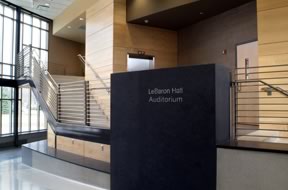
Auditorium Layout
The auditorium is laid out in a 75-degree arc. The seating is placed on six tiers, each tier containing two rows running the width of the auditorium This wider design kept the depth of the auditorium to a minimum, only 12 rows deep, so even back-row students feel closer to the instructor. (The original auditorium was more than twice that depth.) Two aisles bisect the auditorium roughly into thirds, allowing the instructor to easily maneuver in and around the students. A walkway between the fourth and fifth row, suitable for wheelchair access, also allows the instructor to work through the room horizontally. In addition, all other rows are wide enough for the instructor to maneuver down each row. The instructor can reach each student in the class, either while lecturing or acting as a facilitator during group activities. This same broad spacing of the rows allows students to move around during group activities, to easily reach the front of the auditorium to share a report with their peers, or to work on the whiteboard at the front of the hall. (See Figure 2.)
Figure 2. Easy Passage Through the Auditorium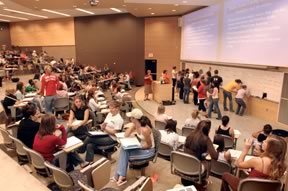
Customized Seat Design
A notable feature of the LeBaron Hall Auditorium is the design of some of its seats. To facilitate group interaction, auditorium designers sought chairs that swiveled to allow students to turn to one another during peer-to-peer activities. Classroom chairs were researched; the swivel chairs discovered only allowed a 180-degree turn. This effectively allowed students to turn to their left or directly behind them, but limited all movement to the students' right.
Auditorium designers worked with an educational furniture manufacturer to come up with a chair that provided more flexibility. The manufacturer agreed to modify an existing 180-degree swivel chair to reach 240 degrees. This allows students to turn their chairs to face most adjacent peers. Due to this advanced arc, the chair's "spring back to front" feature had to be disabled. This actually benefits students, who now don't have to subconsciously fight the chair's spring to stay facing a neighbor. It causes minor problems for janitorial staff, however, as they must maneuver around chairs that are left facing all different directions.
While ideally all seats in the auditorium would have this same swivel flexibility, cost constraints did not allow it. Consequently, the seats in the front row of each tier are swivel seats, while the back row of each tier is equipped with a row of fixed seats. (See Figure 3.) Student groups collect themselves for activities with other students adjacent on the same tier. (See Figure 4.)
Figure 3. Swivel Seats in Front of Fixed Seats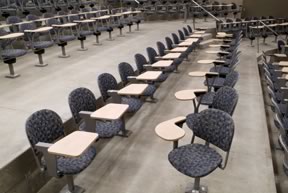
Figure 4. Students Face Peers in Work Groups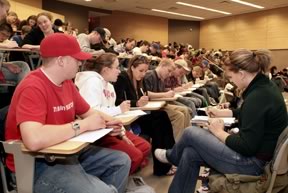
Wheelchair Access
In addressing Americans with Disabilities Act (ADA) requirements, designers wanted the auditorium to be as accommodating as possible. Many older auditoriums are retrofitted for wheelchair access with space either in the front or back of the auditorium. The LeBaron Hall Auditorium has six separate wheelchair stations, on the first, third, and sixth tiers, allowing the wheelchair-bound to have a greater selection in seating. An elevator immediately outside the auditorium provides access to all three levels.
What Happens Here?
The LeBaron Hall Auditorium is intended primarily for ISU classes. The most frequent auditorium users wanted a space where students could interact in a variety of ways, with their instructor and with their peers. The hope is to populate the auditorium with classes that emphasize activities for student engagement. (See Figure 5.)
Figure 5. LeBaron Supports Student Activities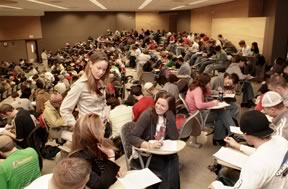
A secondary purpose of the auditorium is to host guest lectures and to record them via high-quality video systems. A third purpose, not yet enabled, is to electronically view best practices in the auditorium. Once funding is available, the room will be equipped with technology that will allow ISU's Center for Excellence in Learning and Teaching to observe instructors for faculty development purposes.
How Is Technology Used?
The electronic technology available in the room is consistent with the highest level of classroom support provided in ISU's 222 general classrooms. Electronic technology in the LeBaron Hall Auditorium includes:
- Dual projection to a single, continuous, double-wide projection surface. The instructor can send any input to either projector. The ceiling height allows projection above the whiteboard, letting the faculty member use both instructional tools simultaneously.
- Projector input devices that can be used by the instructor include a laptop computer, digital document camera, and a DVD/VCR combination player. (See Figure 6.)
Figure 6. Video and Media Volume Controls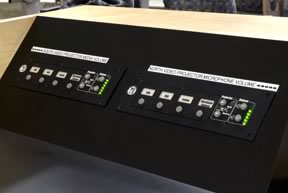
- A simple control system for instructors. (See Figure 7.) The RS-232 control system is the same in all technology equipped classrooms on campus, so instructors can move from classroom to classroom without having to learn a new interface. The system can be remotely monitored for device usage, projector lamp hours, and system status. If an instructor needs assistance, classroom technology support staff can control or switch devices remotely.
Figure 7. Instructor's Control Station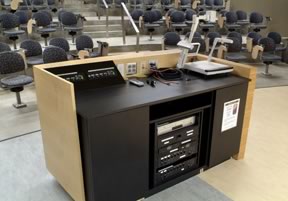
- A two-amplifier sound system. One amplifier drives the front-mounted speakers, which are the primary sound source for the audience. The second amplifier drives a distributed speaker system above the audience seating, for sound reinforcement.
- A wireless lavalier microphone for the primary speaker and a wireless handheld microphone for passing around to students during any student input session.
- Wireless access (802.11g).
- A student response system receiver, for faculty who wish to use student clickers.
- Independent control of lighting elements for the speaker, the whiteboard, the projection screens, and the remainder of the auditorium.
- A yet-to-be-enabled IP video camera system that would allow people external to the class to view instructor best practices, with permission.
- Any additional technology, while not standard in each classroom, can be accessed and installed for faculty members on request.
What Makes the Space Successful?
The ability to make the space as interactive as possible is a key success factor in LeBaron Hall Auditorium's design. While several classrooms on campus host the same or similar electronic technology, the seating layout and swivel-seat design allow for student participation and active learning. (See Figure 8.)
Figure 8. Seating Layout Promotes Participation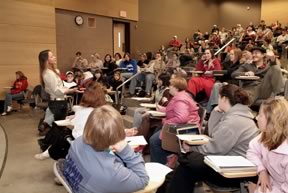
The design decisions were not arrived at quickly. The design committee included facility planners, space management staff, learning and teaching experts, faculty users, and technology providers. Each constituency was receptive to the needs and concerns of the others—probably the most important factor to success. The facility planners, for instance, under pressures of economy and efficiency, were used to assigning a certain number of classroom seats per square foot. Faculty and student learning experts wanted to promote student interaction and faculty mobility, both of which reduce the number of seats possible in a fixed space. The result is a compromise. A less-collaborative group could not have achieved the same result.1
What Principles Were Behind the Design?
The auditorium design and technology selection addressed four of Chickering and Gamson's seven principles for good practice in undergraduate education.2 The resulting learning space greatly improves contact between the faculty member and students. Active learning is facilitated, in part, through group interaction. Student reciprocity and cooperation are promoted through the social, collaborative atmosphere of the auditorium. The close proximity with the instructor and electronic technology in the room provide ample opportunities for prompt feedback.
The redesigned space has a new, rejuvenated feel. Strategically placed, rich-grained wood paneling provides warmth, while cushioned chairs offer comfortable seating.
What Is Unique or Noteworthy?
Faculty and students alike have commented on LeBaron Hall Auditorium's new environment. Corly Brooke of the Center for Excellence in Teaching and Learning stated, "The best thing it does for my students is create community in the classroom—I can see all the students, and I can get them interacting easily." (See Figure 9.) Students who experienced the auditorium commented, "It is my favorite classroom on campus. I felt close to the instructor and ready to learn," and "No matter where I sat in the room, I felt closely connected with the instructor." Another comment illustrates the importance of the swivel seating: "This was so helpful during group discussions and projects. It turned a classroom of 350+ into a small group of four who were able to communicate as though we were the only ones in the room with the instructor."
Figure 9. Faculty-Student Interaction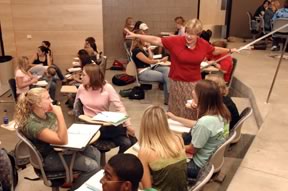
The design and construction of the new LeBaron Hall Auditorium was a team effort, in the truest sense—and now the students can work in teams too.
Endnotes
- Champions in the design of the LeBaron Hall Auditorium include Dr. Corly Brooke, professor and director of the Center for Excellence in Learning and Teaching; Dr. Mary Gregoire, professor and chair of apparel, educational studies, and hospitality management; Kathleen Baumgarn, manager of classroom facilities space management; Matthew Darbyshire, manager of classroom services, information technology services; Mark Grief, facilities project manager; architects Baldwin & White of Des Moines, Iowa; and educational furniture manufacturer KI of Green Bay, Wisconsin.
- A. W. Chickering and Z. F. Gamson, "Seven Principles for Good Practice in Undergraduate Education," AAHE Bulletin, vol. 39, no. 7 (1987), pp. 3–7.
About the Author
Jim Twetten is the assistant director of academic technologies, information technology services, at Iowa State University.